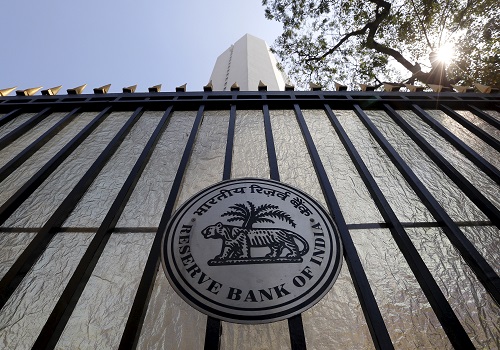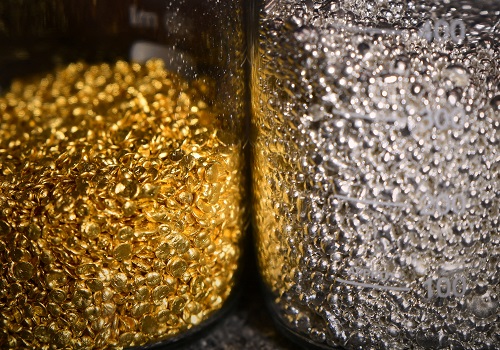Turmeric trading range for the day is 7342-8046 - Kedia Advisory

Follow us Now on Telegram ! Get daily 10 - 12 important updates on Business, Finance and Investment. Join our Telegram Channel
Gold
Gold yesterday settled down by -0.4% at 47318 as dollar firms up despite signs of weakness in the U.S. jobs market dented investor expectations about the pace of economic recovery. U.S. weekly jobless claims fell less than expected and core consumer prices rose at a slower pace, causing some traders to temper their optimism about the economic outlook. Last week's nonfarm payrolls data showed the world's largest economy added a meager 49,000 jobs in January, signaling the ongoing fragility of the recovery. India's gold imports in January surged 72% from a year earlier, a government source said, as a correction in prices from a record high drew retail buyers and jewellers. The world's second-biggest consumer of the gold imported around 62 tonnes of it in January, up from 36.5 tonnes a year ago. The Venezuelan central bank's gold reserves dropped by about 12 tonnes in the last six months to a new 50-year low, according to its 2020 financial statements. Over the course of 2020, reserves from the central bank's vaults in Caracas fell by 19 tonnes. Withdrawals accelerated in the second half of the year, when 12 tonnes were removed. Reserves have dropped to 86 tonnes, their lowest in 50 years, according to the notes on the bank's financial statements. Technically market is under fresh selling as market has witnessed gain in open interest by 0.96% to settled at 12655 while prices down -190 rupees, now Gold is getting support at 47090 and below same could see a test of 46863 levels, and resistance is now likely to be seen at 47565, a move above could see prices testing 47813.
Trading Ideas:
* Gold trading range for the day is 46863-47813.
* Gold prices eased as dollar firms up as signs of weakness in the U.S. jobs market dented investor expectations about the pace of economic recovery.
* U.S. weekly jobless claims fell less than expected and core consumer prices rose at a slower pace, causing some traders to temper their optimism about the economic outlook.
* India's January gold imports surge 72% y/y to 62 T
Silver
Silver yesterday settled up by 0.91% at 69117 on doubts about the strength of the U.S. economic recover despite dollar edged higher. Federal Reserve Chairman Jerome Powell said, a "patiently accommodative monetary policy stance" is important to boost the labor market and the overall economy following a stall in recent months. A report from the University of Michigan showed an unexpected decrease in U.S. consumer sentiment in the month of February. The report said the consumer sentiment index fell to 76.2 in February after edging down to 79.0 in January. The decline by the headline index came as the index of consumer expectations slumped to 69.8 in February from 74.0 in the previous month. The current economic conditions index showed a much more modest decrease, edging down to 86.2 in February from 86.7 in January. The U.S. economy is still in the "teeth" of the pandemic, the labor market is far from full employment, Dallas Federal Reserve Bank President Robert Kaplan said. While the distribution of coronavirus vaccines could boost mobility and economic growth, some of the people who lost jobs during the crisis will need help training for new work, Kaplan said. Japan's economy will suffer a much bigger contraction than initially expected in the January-March quarter, as an extended state of emergency to contain the coronavirus pandemic hurt corporate and household spending. Technically market is under fresh buying as market has witnessed gain in open interest by 0.67% to settled at 12563 while prices up 625 rupees, now Silver is getting support at 68464 and below same could see a test of 67812 levels, and resistance is now likely to be seen at 69634, a move above could see prices testing 70152.
Trading Ideas:
* Silver trading range for the day is 67812-70152.
* Silver prices gains on doubts about the strength of the U.S. economic recover despite dollar edged higher.
* Fed Chairman Powell said, a "patiently accommodative monetary policy stance" is important to boost the labor market
* Fed's Kaplan says labor market still far from maximum employment
Crude oil
Crude oil yesterday settled up by 1.98% at 4325 rebounding from early losses, as tensions in the Middle East raised the possibility of disruptions in crude supplies. World oil demand in 2021 will rebound more slowly than previously thought, OPEC said, adding to a series of downgrades as the impact of the pandemic lingers. Demand will rise by 5.79 million barrels per day (bpd) this year to 96.05 million bpd, the Organization of the Petroleum Exporting Countries said in a monthly report, trimming its growth forecast by 110,000 bpd from a month ago. Global oil supply still outstrips demand due to persistent COVID-19 lockdowns and the spread of variants, the International Energy Agency (IEA) said, but vaccines should help demand recover and soon enable producers to pump more. "With demand forecast to rise strongly and still modest growth in non-OPEC supply expected, a rapid stock draw is anticipated during the second half of the year." Despite plans to increase its output, data shows Russia's February 1-10 oil and gas condensate production actually edged down to 10.11 million barrels per day (bpd) from 10.16 million bpd on average in January. From February, Russia is due to raise its oil output by 65,000 bpd, as the OPEC+ group of leading oil producers have agreed to ease curbs introduced by producers to support prices and taper oversupply. Technically market is under short covering as market has witnessed drop in open interest by -12.75% to settled at 2709 while prices up 84 rupees, now Crude oil is getting support at 4223 and below same could see a test of 4121 levels, and resistance is now likely to be seen at 4387, a move above could see prices testing 4449.
Trading Ideas:
* Crude oil trading range for the day is 4121-4449.
* Crude oil prices moved higher rebounding from early losses, as tensions in the Middle East raised the possibility of disruptions in crude supplies.
* OPEC again cuts 2021 oil demand view, sees H2 pickup
* Oil market rebalancing will soon set stage for more OPEC+ supply -IEA
Nat.Gas
Nat.Gas yesterday settled up by 2.92% at 215.3 ahead of the long U.S. Presidents Day weekend after forecasts called for even colder weather over the next two weeks than previously expected. In their latest forecasts, meteorologists projected average U.S. temperatures will remain well below normal through Feb. 21. Starting Feb. 22, however, the weather was expected to turn mild and stay that way through the end of the month. In the spot market, meanwhile, power gas prices across North America soared to their highest in years as freezing wells cut output and homes and businesses cranked up their heaters to escape the arctic blast moving across Canada and the United States. Data provider Refinitiv said output in the Lower 48 U.S. states has averaged 89.6 billion cubic feet per day (bcfd) so far in February. Traders noted that was down from 91.1 bcfd in January, due in part to the freezing of some wells. Output hit an all-time monthly high of 95.4 bcfd in November 2019. On a daily basis, output was on track to drop from 87.7 bcfd on Thursday to 85.3 bcfd on Friday, the lowest since mid October, according to preliminary data from Refinitiv that will likely be revised later in the day. Technically market is under short covering as market has witnessed drop in open interest by -4.99% to settled at 7633 while prices up 6.1 rupees, now Natural gas is getting support at 208.8 and below same could see a test of 202.3 levels, and resistance is now likely to be seen at 219.2, a move above could see prices testing 223.1.
Trading Ideas:
* Natural gas trading range for the day is 202.3-223.1.
* Natural gas edged up after forecasts called for even colder weather over the next two weeks than previously expected.
* In their latest forecasts, meteorologists projected average U.S. temperatures will remain well below normal through Feb. 21.
* Starting Feb. 22, however, the weather was expected to turn mild and stay that way through the end of the month.
Copper
Copper yesterday settled up by 0.68% at 641.15 as demand outpaces supply with Chinese markets closed for the week-long Lunar New Year holiday. Copper inventories in warehouses registered with the LME and Comex exchange are falling, with LME stocks near their lowest since 2005 at 73,500 tonnes. Inventories in Shanghai Futures Exchange warehouses fell in January to their lowest since 2011 before rising slightly to 78,571 tonnes. Cash copper has flipped to a premium against the three-month contract, pointing to tight supply of nearby metal. The premium hit $17.50 a tonne this week before slipping to $3.50. Rough seas and a shortage of containers have bogged down shipments of copper cathodes from Chile, the world’s largest producer, and could continue to slow exports. China's major copper smelters cut output by 10.5% month-on-month in January after racing to meet annual targets in December, while Daye Nonferrous carried out maintenance. Daye's maintenance has just ended, a company official said, and most smelters have no maintenance plans for February, which nonetheless sees output falling to around 725,000 tonnes in this shorter month. According to smelters’ production schedules, China’s copper cathode output to increase 1.71% on the month and 18.86% on the year to 812,000 mt in February, as several smelters recover from maintenance. Technically market is under fresh buying as market has witnessed gain in open interest by 2.45% to settled at 4217 while prices up 4.3 rupees, now Copper is getting support at 633.9 and below same could see a test of 626.7 levels, and resistance is now likely to be seen at 645.8, a move above could see prices testing 650.5.
Trading Ideas:
* Copper trading range for the day is 626.7-650.5.
* Copper prices gains as demand outpaces supply with Chinese markets closed for the week-long Lunar New Year holiday.
* Copper inventories in warehouses registered with the LME and Comex exchange are falling
* Rough seas and a shortage of containers have bogged down shipments of copper cathodes from Chile, the world’s largest producer, and could continue to slow exports.
Zinc
Zinc yesterday settled up by 1.1% at 224.3 on prospects for strong steel demand after the Lunar New Year, even though the holiday break in China drained volumes from the market. Prices for zinc, used in galvanising, rallied in the tailwind of steel, which has firmed on expectations of strong demand after the new year break, and as countries look to boost infrastructure spending to offset the COVID-19 economic malaise. Chinese zinc smelters boosted output by 5.9% year-on-year to 484,000 tonnes in January, as it predicted zinc treatment charges languishing at two-year lows would soon bottom out. The enlarged survey of 51 zinc smelters was released on the same day China's industry ministry vowed to continue cracking down on "disorderly" smelting capacity expansion in lead and zinc after record output in 2020. Daily zinc output in January fell 0.3% from December and will drop another 2.3% in February, as some smelters run maintenance or reduce operations over the Lunar New Year holiday starting this week. Spot charges paid to smelters to process zinc concentrate plunged more than 70% in 2020 as coronavirus curbs tightened mine supply, although Antaike said they were already rising slightly in parts of southern China. Technically market is under fresh buying as market has witnessed gain in open interest by 2.5% to settled at 1968 while prices up 2.45 rupees, now Zinc is getting support at 221.9 and below same could see a test of 219.6 levels, and resistance is now likely to be seen at 225.7, a move above could see prices testing 227.2.
Trading Ideas:
* Zinc trading range for the day is 219.6-227.2.
* Zinc prices gained to its best weekly performance since November on prospects for strong steel demand after the Lunar New Year
* Prices for zinc, firmed on expectations of strong demand after the break, and as countries look to boost infrastructure spending
* China’s factory gate prices rose in annual terms in January for the first time in 12 months and at the fastest rate since May 2019
Nickel
Nickel yesterday settled down by -0.52% at 1343.6 as investors kept tapping the brakes on runs in prices after taking in tepid U.S. inflation data and comments from the Federal Reserve chief affirming the outlook for a slow recovery. The January volume was also down 7.9% from December, adding it sees February output dipping slightly due to the Lunar New Year holiday and noting Jien Nickel did not plan to resume production until April. China's output of stainless steel raw material nickel pig iron (NPI) meanwhile rose 4.8% in January from the previous month to 39,300 tonnes on a nickel content basis, which was still down 12.7% year-on-year. Stainless steel production in China rose 3% to 30.43 million tonnes last year, which sees output climbing another 4.5% in 2021 to 31.8 million tonnes. China's refined nickel cathode output fell 7.8% year-on-year to 12,981 tonnes in January, as maintenance and suspensions meant only Jinchuan and one other smelter were producing. Producers of nickel pig iron in Indonesia are looking at converting their material into an intermediate product that can be turned into nickel chemicals for the lucrative electric vehicle market. Goldman Sachs raised the expected size of the US stimulus bill to US$ 1.5 trillion, and raised the expected growth rate of US GDP to 6.8% and 4.5% this year and next respectively. Technically market is under long liquidation as market has witnessed drop in open interest by -14.08% to settled at 1898 while prices down -7 rupees, now Nickel is getting support at 1327.8 and below same could see a test of 1311.9 levels, and resistance is now likely to be seen at 1356.8, a move above could see prices testing 1369.9.
Trading Ideas:
* Nickel trading range for the day is 1311.9-1369.9.
* Nickel prices dropped as investors kept tapping the brakes on runs in prices after taking in tepid U.S. inflation data
* China's refined nickel cathode output fell 7.8% year-on-year to 12,981 tonnes in January
* China’s refined nickel output to fall to 12,000 mt in February 2021 due to shorter operating days of the month.
Aluminium
Aluminium yesterday settled up by 0.3% at 168.2 as consumption shrank, and the demand for capital hedging should continue to be monitored. China’s factory gate prices rose in annual terms in January for the first time in 12 months and at the fastest rate since May 2019, suggesting gathering growth momentum for the world’s second-largest economy. The producer price index (PPI) rose 0.3% from a year earlier, the National Bureau of Statistics said in a statement. PPI declined 0.4% in December. The Chinese economy is expected to grow 8.4% this year, following a 2.3% rise in 2020 in the wake of the COVID-19 pandemic that forced the country to shut down for much of the March quarter last year. Stocks of aluminium billet across five major consumption areas in China increased by 37,400 tonnes on lower shipments due to the Chinese New Year holiday. The stocks came in at 165,500 tonnes as of Wednesday February 10. Aluminium billet shipments stood at 14,000 tonnes this week. Shipments dropped by 13,300 tonnes. Primary aluminium ingot inventories in China have continued to build-up this week, on Wednesday, February 10. Data shows the stocks have significantly gained 61,000 tonnes across eight major consumption areas in China, including SHFE warrants, to come in at 775,000 tonnes. Technically market is under fresh buying as market has witnessed gain in open interest by 5.67% to settled at 857 while prices up 0.5 rupees, now Aluminium is getting support at 167.5 and below same could see a test of 166.6 levels, and resistance is now likely to be seen at 168.9, a move above could see prices testing 169.4.
Trading Ideas:
* Aluminium trading range for the day is 166.6-169.4.
* Aluminium prices gained as consumption shrank, and the demand for capital hedging should continue to be monitored.
* Stocks of aluminium billet across five major consumption areas in China increased by 37,400 tonnes on lower shipments
* The producer price index (PPI) rose 0.3% from a year earlier, the National Bureau of Statistics said in a statement
Mentha oil
Mentha oil yesterday settled up by 0.75% at 969.3 on low level buying after prices dropped due to weak demand from cosmetics and toiletries sector in India. The COVID-19 outbreak has had a huge impact on the worldwide economy, and has posed a similar influence on the aroma chemicals market. The market has been faced with the lack of migrant labor, supply chain disruptions, shutdown of manufacturing activities, to name a few. Support also seen on the expectation that India’s fragrance industry which had been slow, now slowly gaining the positive momentum post the COVID unlock down. Headed towards a new decade, the fragrance industry has received a much needed boost with the acceptance of trendy dhoop sticks and dhoop cones which has seen an increased 20% demand day by day. The global aroma chemicals market is likely to record a steady CAGR of about 4% during the assessment period of 2020-2030. Growing demand for aroma chemicals in the food & beverage and fragrance industry will underpin the growth of the market. Strict regulations in relation to artificial flavours are complimenting to the expansion of natural aroma chemicals in the food sector. Out of India's total mentha oil exports, nearly 55% goes to China while 16% goes to the US and around 5% goes to Singapore. In Sambhal spot market, Mentha oil dropped by -1.9 Rupees to end at 1128.6 Rupees per 360 kgs. Technically market is under short covering as market has witnessed drop in open interest by -1.52% to settled at 65 while prices up 7.2 rupees, now Mentha oil is getting support at 961.5 and below same could see a test of 953.8 levels, and resistance is now likely to be seen at 974.4, a move above could see prices testing 979.6.
Trading Ideas:
* Mentha oil trading range for the day is 953.8-979.6.
* In Sambhal spot market, Mentha oil dropped by -1.9 Rupees to end at 1128.6 Rupees per 360 kgs.
* Mentha oil gained on low level buying after prices dropped due to weak demand from cosmetics and toiletries sector in India.
* The COVID-19 outbreak has had a huge impact on the worldwide economy, and has posed a similar influence on the aroma chemicals market.
* The global aroma chemicals market is likely to record a steady CAGR of about 4% during the assessment period of 2020-2030.
Soyabean
Soyabean yesterday settled down by -0.23% at 4774 on late profit booking after prices gained as data revealed that Soybean meal exports rise six-fold in January which ultimately shows high demand of soybean in global market. Support also seen as WASDE report revealed lower production and stock of soybean, soybean carryout at 120 million bushels. Support also seen as Argentina faces lower rainfall in recent months due to a moderate La Nina weather phenomenon had caused uncertainty over harvests from the country. The U.S. soybean stocks-to-use ratio for the 2020/21 season fell to 2.61%, the lowest on record going back to the 1964/65 season, according to USDA data. Soybean world ending stocks have been cut to 83.36Mt from 84.31Mt, and the estimate for China’s soybean imports was unchanged at 100Mt. Though high prices been capped as Soybean production in Brazil will reach a record 133.817 million tonnes, the country's agricultural statistics agency, Conab, predicted. Concern is also arising as Bird flu spreading across country and it is causing huge loss to Poultry industry, as data showed at the national level, the loss of the poultry industry is estimated to be at Rs.3400 cr, this is also affecting the demand of soybean at domestic front. Soybean meal exports stood at 58,000 tonne, Indonesia (79,375 tonne), France (70,500 tonne) and Germany (48,765 tonne) were among major importers in January this year. At the Indore spot market in top producer MP, soybean gained 32 Rupees to 4949 Rupees per 100 kgs. Technically market is under fresh selling as market has witnessed gain in open interest by 0.32% to settled at 225810 while prices down -11 rupees, now Soyabean is getting support at 4747 and below same could see a test of 4721 levels, and resistance is now likely to be seen at 4817, a move above could see prices testing 4861.
Trading Ideas:
* Soyabean trading range for the day is 4721-4861.
* Soybean dropped on late profit booking after prices gainedas data revealed that Soybean meal exports rise six-fold in January
* Support also seen as WASDE report revealed lower production and stock of soybean, soybean carryout at 120 million bushels.
* Argentina faces lower rainfall in recent months due to a moderate La Nina weather phenomenon had caused uncertainty over harvests from the country.
* At the Indore spot market in top producer MP, soybean gained 32 Rupees to 4949 Rupees per 100 kgs.
Ref.Soyaoil
Ref.Soyaoil yesterday settled up by 0.13% at 1120.2 on short covering after pressure seen on prices as India's edible oil consumption is expected to contract for the second straight year in 2020/21 as a rally in vegetable oil prices to multi-year highs curbs retail buying, industry officials told. Edible oil consumption could fall to 21 million tonnes in 2019/20 marketing year ending on Oct. 31 from 22 million a year earlier, he said. In 2018/19 demand was around 23 million tonnes. India's edible oil consumption usually rises by 2-3% per annum because of rising population and prosperity, but this year it will likely fall by around 5%, he said. Lower consumption would reduce imports as India fulfils more than 70% of its demand through imports. "Imports fell last year due to lockdown. This year a combination of very high prices and increased availability of oilseeds would bring down imports," said Atul Chaturvedi, president of the Solvent Extractors Association of India. India's edible oil imports could fall to 12.5 million tonnes in 2020/21 from last year's 13.2 million, the lowest in six years, Chaturvedi said. The country imports palm oil mainly from Indonesia and Malaysia, and other oils such as soy and sunflower oil from Argentina, Brazil, Ukraine and Russia. At the Indore spot market in Madhya Pradesh, soyoil was steady at 1127.2 Rupees per 10 kgs. Technically market is under short covering as market has witnessed drop in open interest by -1.22% to settled at 36165 while prices up 1.5 rupees, now Ref.Soya oil is getting support at 1113 and below same could see a test of 1105 levels, and resistance is now likely to be seen at 1128, a move above could see prices testing 1135.
Trading Ideas:
* Ref.Soya oil trading range for the day is 1105-1135.
* Ref soyoil gained on short covering after seen pressure as India's edible oil consumption is expected to contract in 2020/21
* Edible oil consumption could fall to 21 million tonnes in 2019/20 marketing year ending on Oct. 31 from 22 million a year earlier
* Soyoil imports could drop marginally from last year's 3.4 million tonnes
* At the Indore spot market in Madhya Pradesh, soyoil was steady at 1127.2 Rupees per 10 kgs.
Crude palm Oil
Crude palm Oil yesterday settled up by 0.35% at 1015.6 lifted by a jump in exports during Feb. 1-10 despite higher than expected end-January inventories. Malaysia's palm oil inventories rose more than expected in January as exports plunged to a near 14-year low while output continued to decline, data from the Malaysian Palm Oil Board (MPOB) showed. Stockpile in the world's second largest producer increased 4.7% to reach 1.32 million tonnes at the end of January from the month prior, rising for the first time in four months. January inventories were expected to rise 1.8% to 1.29 million tonnes. Crude palm oil production fell more than expected to its lowest since February 2016. It slumped 15.5% in January to 1.13 million tonnes, falling for a fourth straight month due to rainy weather and a pandemic-induced labour crunch, and against expectations for smaller 13% fall. Palm oil exports also slumped more than expected to their lowest since February 2007. Exports plunged 42.3% to 947,395 tonnes, data from the industry regulator showed, against expectations for a 35% fall. Exports from Malaysia during Feb. 1-10 rose between 47% to 54% from the same period in January, cargo surveyors said. February's exports were seen recovering sharply over a very weak base of Jan. 1-10's exports, however, the rise is primarily due to a delay in January shipments which sailed in February. In spot market, Crude palm oil gained by 2.3 Rupees to end at 1014.6 Rupees. Technically market is under short covering as market has witnessed drop in open interest by -0.43% to settled at 5308 while prices up 3.5 rupees, now CPO is getting support at 1008.5 and below same could see a test of 1001.4 levels, and resistance is now likely to be seen at 1020.2, a move above could see prices testing 1024.8.
Trading Ideas:
* CPO trading range for the day is 1001.4-1024.8.
* Crude palm oil gains lifted by a jump in exports during Feb. 1-10 despite higher than expected end-January inventories.
* Malaysia's palm oil inventories rose more than expected in January as exports plunged to a near 14-year low while output continued to decline
* Stockpile in the world's second largest producer increased 4.7% to reach 1.32 million tonnes at the end of January from the month prior
* In spot market, Crude palm oil gained by 2.3 Rupees to end at 1014.6 Rupees.
Mustard Seed
Mustard Seed yesterday settled up by 0.61% at 5293 amid crop damage in north due to cold waves. Year on year, the planted area of mustard has increased by 6.7 percent approximately. The latest Government data shows that the planted area in Mustard or RM seed has so far reached 73.25 Lakh hectares as against 68.64 Lakh hectares during last year’s corresponding period. The government aims to take the area under mustard to around 80 lakh hectares this year, under the Oilseeds Mission program. The mustard crop continues providing better prices to farmers than the MSP till now. India’s 2020-21 mustard crop may touch 100 lakh ton-level due to higher sowing and conducive weather. The sowing of oilseed crops has increased to 81.80 lakh hectares in the current Rabi whereas till this time last year, it was sown only in 77.79 lakh hectares. At the national level, the total production area of rabi crops increased to 620.71 lakh hectare, compared to 603.15 lakh hectare to 17.56 lakh hectare or 2.91 percent and the general average area from 620.27 lakh hectare to 44 thousand hectare in the same period last year. In Alwar spot market in Rajasthan the prices gained 52.15 Rupees to end at 6500 Rupees per 100 kg. Technically market is under fresh buying as market has witnessed gain in open interest by 2.96% to settled at 27130 while prices up 32 rupees, now Rmseed is getting support at 5262 and below same could see a test of 5232 levels, and resistance is now likely to be seen at 5326, a move above could see prices testing 5360.
Trading Ideas:
* Rmseed trading range for the day is 5232-5360.
* Mustard seed prices gained amid crop damage in north due to cold waves.
* New mustard arrivals will start in Uttar Pradesh's mandis.
* Production area of the Rabi season has reached a height of 73.94 lakh hectare
* In Alwar spot market in Rajasthan the prices gained 52.15 Rupees to end at 6500 Rupees per 100 kg.
Turmeric
Turmeric yesterday settled up by 2.86% at 7756 due to the possibility of 25 percent crop loss in Telangana and Andhra Pradesh. Even in Sangli district of Maharashtra, the crop has been affected. There are expectation of decrease in Turmeric sown area in the kharif sowing season 2020 across Nizamabad and Marathwada regions. Covid-19 raised expectations regarding the consumption of turmeric as a body immune enhancer, but it did not last long. Poor quality of arrivals is another reason for the drop in demand. Therefore, many traders in Erode started buying turmeric from the markets of Andhra Pradesh and Maharashtra as the prices were low there. Despite 2% freight, they are saving 5% on costs. Apprehensions are there that water logging and higher moisture due to recent rains in October in major Turmeric growing regions of Telangana, Maharashtra, Karnataka is likely to have adverse impact on overall productivity of Turmeric. Stockiest are getting active and started purchasing actively due to factors like decreasing sowing area and increasing demand. On the export front, India exported around 0.86 lakh tonnes of Turmeric in April-August, 2020 which is 51% higher than April-August, 2019 at 0.57 lakh tonnes. In Nizamabad, a major spot market in AP, the price ended at 7260.55 Rupees gained 3.55 Rupees. Technically market is under short covering as market has witnessed drop in open interest by -2.33% to settled at 7765 while prices up 216 rupees, now Turmeric is getting support at 7550 and below same could see a test of 7342 levels, and resistance is now likely to be seen at 7902, a move above could see prices testing 8046.
Trading Ideas:
* Turmeric trading range for the day is 7342-8046.
* Turmeric prices rallied due to the possibility of 25 percent crop loss in Telangana and Andhra Pradesh.
* Even in Sangli district of Maharashtra, the crop has been affected.
* Covid-19 raised expectations regarding the consumption of turmeric as a body immune enhancer, but it did not last long
* In Nizamabad, a major spot market in AP, the price ended at 7260.55 Rupees gained 3.55 Rupees.
Jeera
Jeera yesterday settled up by 0.15% at 13425 due to constraints in supply as the end of season approaches. Support was also seen from the export side as exporters switched to Indian cumin seed this time. Weather conditions remain supportive and traders are avoiding buying large quantities in the wholesale markets before the new arrivals from next month. Demand for Indian Cumin has improved from UAE and Vietnam in recent months. Acreage under Jeera in leading producing state of Gujarat was at 4.64 lakh hectares (lh), marking a jump of around 11% compared to the same time last year which may not allow any significant price appreciation of cumin in coming weeks. Some support seen as a statement from the Spices Board said the export of spices, which had fetched ₹12,273.81 crores in the first half of the current fiscal between April and September, had grown by 19 per cent compared to the corresponding period last year. As India going to start it vaccination in the whole country from 16th January onwards it is raising the expectation of trader regarding the boost in demand of Jeera from export as well as from domestic which was dropped in 2020 due to Covid. In Unjha, a key spot market in Gujarat, jeera edged down by -40.6 Rupees to end at 13058.8 Rupees per 100 kg. Technically market is under short covering as market has witnessed drop in open interest by -2.58% to settled at 1134 while prices up 20 rupees, now Jeera is getting support at 13310 and below same could see a test of 13195 levels, and resistance is now likely to be seen at 13560, a move above could see prices testing 13695.
Trading Ideas:
* Jeera trading range for the day is 13195-13695.
* Jeera prices gained due to constraints in supply as the end of season approaches.
* Support was also seen from the export side as exporters switched to Indian cumin seed this time.
* Demand for Indian Cumin has improved from UAE and Vietnam in recent months.
* In Unjha, a key spot market in Gujarat, jeera edged down by -40.6 Rupees to end at 13058.8 Rupees per 100 kg.
Cotton
Cotton yesterday settled down by -0.23% at 21400 as pressure seen after the Union Ministry of Textiles’ Committee on Cotton Production and Consumption (COCPC) has projected a higher crop at 371 lakh bales (each of 170 kg) for the year 2020-21. Cotton trade had estimated the crop size at 358.50 lakh bales. In its meeting, the Committee, estimated the average cotton yield of 486.76 kg per hectare, up from 463.99 kg reported in the previous year. For the previous year, projected cotton crop size of 365 lakh bales in the country. As per the latest projections, Gujarat will be the largest cotton-growing State with 90.5 lakh bales and one of the highest yields at 676.86 kg per hectare. Rajasthan, with 27 lakh bales, is expected to have highest cotton yield at 683.04 kg. Besides Gujarat, the top three cotton growing states include Maharashtra with 86 lakh bales with 349.43 kg yield and Telangana with 60 lakh bales and 429.84 kg of cotton yield. Commenting on the cotton crop projections, J Thulasidharan, Chairman of Indian Cotton Federation, said that a higher crop would pose a serious challenge for India to clear huge stocks of the fibre crop. As per the government estimate, closing stock for 2020-21 is likely to be 97.95 lakh bales, as comapred to 120.95 lakh bales recorded last year. In spot market, Cotton gained by 120 Rupees to end at 21400 Rupees. Technically market is under long liquidation as market has witnessed drop in open interest by -7.59% to settled at 5308 while prices down -50 rupees, now Cotton is getting support at 21350 and below same could see a test of 21300 levels, and resistance is now likely to be seen at 21500, a move above could see prices testing 21600.
Trading Ideas:
* Cotton trading range for the day is 21300-21600.
* Cotton prices dropped as pressure seen after COCPC estimate is higher by 12.5 lakh bales over trade projections
* The Committee, estimated the average cotton yield of 486.76 kg per hectare, up from 463.99 kg reported in the previous year.
* For the previous year, projected cotton crop size of 365 lakh bales in the country.
* In spot market, Cotton gained by 120 Rupees to end at 21400 Rupees.
Chana
Chana yesterday settled up by 0.78% at 4645 as chana growers are worried of non-realisation of the MSP. In Maharashtra, the bigger concern for farmers is now the fate of their chana crop as the pulse continues to rule below its MSP of Rs 5,100 per quintal. The government should speed up its plans for chana procurement, otherwise the farmers will not realise the MSP. The Centre allocated around 121 lakh metric tonnes (LMT) of free foodgrain under PMGKAY-I (Pradhan Mantri Garib Kalyan Anna Yojana) at the financial cost of around Rs 46,061 crore, Union Minister of State for Consumer Affairs, Food and Public Distribution. In absence for the new crop, millers are buying gram as per need. During the Rabi season this year, about 112 lakh hectare area has been sown in the gram producing states, which was in 107.30 lakh hectare last year. Weather friendly is likely to increase productivity. Prices are running lower than MSP. The challenge of buying gram will be in front of the government. Selling of chana at the port was seen better. Chana arrivals are increasing in the mandis of Maharashtra. The pressure of new crop arrivals was seen on the markets. In Delhi spot market, chana dropped by -35.4 Rupees to end at 4595 Rupees per 100 kgs. Technically market is under short covering as market has witnessed drop in open interest by -0.74% to settled at 30830 while prices up 36 rupees, now Chana is getting support at 4611 and below same could see a test of 4577 levels, and resistance is now likely to be seen at 4667, a move above could see prices testing 4689.
Trading Ideas:
* Chana trading range for the day is 4577-4689.
* Chana prices gained as chana growers are worried of non-realisation of the MSP.
* In Maharashtra, the bigger concern for farmers is now the fate of their chana crop as the pulse continues to rule below its MSP of Rs 5,100 per quintal.
* Centre distributed free foodgrains, pulses, chana worth Rs 1.38 lakh crore during COVID-19
* In Delhi spot market, chana dropped by -35.4 Rupees to end at 4595 Rupees per 100 kgs.












 320-x-100_uti_gold.jpg" alt="Advertisement">
320-x-100_uti_gold.jpg" alt="Advertisement">












